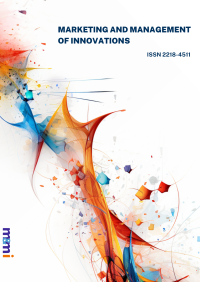Інноваційні підходи до забезпечення кібербезпеки та громадської безпеки: соціально-економічний вимір
- Сумський державний університет, Україна
- Університет WSB, Польща
* Corresponding author
Pages: 127–140
Received: 10 May 2024
Revised: 15 October 2024
Accepted: 26 November 2024
Abstract
Keywords: кіберзлочинність; маніпулювання даними; економічний розвиток; шахрайство; інформаційна доступність; доходи населення; соціальна нерівність.
How to Cite: Tiutiunyk, I., Pozovna, I., & Zaskorski, W. (2024). Innovative Approaches to Ensuring Cybersecurity and Public Safety: The Socio-Economic Dimension. Marketing and Management of Innovations, 15(4), 127–140. https://doi.org/10.21272/mmi.2024.4-10
Abstract Views
PDF Downloads
![]() This work is licensed under a Creative Commons Attribution 4.0 International License
This work is licensed under a Creative Commons Attribution 4.0 International License
References
- Achim, M. V., Văidean, V. L., Borlea, S. N., & Florescu, D. R. (2021). The Impact of the Development of Society on Economic and Financial Crime. Case Study for European Union Member States. Risks, 9(5), 97. [Google Scholar] [CrossRef]
- Afzal, M., Ansari, M. , Ahmad, N., Shahid, M., & Shoed, M. (2024). Cyberfraud, usage intention, and cybersecurity awareness among e-banking users in India: an integrated model approach. Journal of Financial Services Marketing, 29, 1503–1523. [Google Scholar] [CrossRef]
- Ahmead, M., El Sharif, N., & Abuiram, I. (2024). Risky online behaviors and cybercrime awareness among undergraduate students at Al Quds University: a cross sectional study. Crime Science,13, 29. [Google Scholar] [CrossRef]
- AlDairi, A., & Tawalbeh, L. (2017). Cyber Security Attacks on Smart Cities and Associated Mobile Technologies. Procedia Computer Science, 109, 1086–1091. [Google Scholar] [CrossRef]
- Alharbi, N., Alkalifah, B., Alqarawi, G., & Rassam, M. A. (2024). Countering Social Media Cybercrime Using Deep Learning: Instagram Fake Accounts Detection. Future Internet, 16(10), 367. [Google Scholar] [CrossRef]
- Anderson, R., Barton, C., Böhme, R., Clayton, R., Van Eeten, M., Levi, M., Moore, T., & Savage, S. (2019). Measuring the changing cost of cybercrime. Journal of Cybersecurity, 5(1), 1–12. [Google Scholar]
- Bada, M., & Nurse, J. (2019). The Social and Psychological Impact of Cyber-Attacks. Emerging Cyber Threats and Cognitive Vulnerabilities, 73-92. [Google Scholar] [CrossRef]
- Boppre, B., Salisbury, E.J., Parker, J. (2018). Pathways to Crime. In Oxford Research Encyclopedia of Criminology and Criminal Justice. Oxford University Press: Oxford, UK. [Google Scholar] [CrossRef]
- Boussi, O., Gupta, H., & Hossain, S. (2024). A machine learning model for predicting phishing websites. International Journal of Electrical and Computer Engineering (IJECE), 14, 4228. [Google Scholar] [CrossRef]
- Brewer, R., Cale, J., Goldsmith, A., & Holt, T. (2018). Young People, the Internet, and Emerging Pathways into Criminality: A Study of Australian Adolescents. International Journal of Cyber Criminology, 12, 115–132. [Google Scholar] [CrossRef]
- Chen, S., Ding, F., Buil-Gil, D., Hao, M., Maystadt, J. F., Fu, J., … & Jiang, D. (2024). The impact of COVID-19 lockdown on fraud in the UK. Humanities and Social Sciences Communications, 11(1), 1-11. [Google Scholar] [CrossRef]
- Chen, S., Hao, M., Ding, F., Jiang, D., Dong, J., Zhang, S., Guo, Q., & Gao, C. (2023). Exploring the global geography of cybercrime and its driving forces. Humanities and Social Sciences Communications, 10(71). [Google Scholar] [CrossRef]
- Choi, K.S., Chawki, M., & Basu, S. (2024). Digital shadows: analyzing factors influencing sentencing in child sexual abuse material (CSAM) cases. Journal of Aggression, Conflict and Peace Research, 16(4), 363-381. [Google Scholar] [CrossRef]
- Cotrina, L., León, P., Reyes, C., Arbulú Ballesteros, M., Guzmán, M., Castillo, J., Acosta, R., & Morales, A. (2024). Cyber Crimes: A Systematic Review of Evolution, Trends, and Research Approaches.Journal of Educational and Social Research, 14(5), 96. [CrossRef]
- Creese, S., Dutton, W. H. & Esteve-González, P. (2021). The social and cultural shaping of cybersecurity capacity building: a comparative study of nations and regions. Personal and Ubiquitous Computing, 25, 941–955. [Google Scholar] [CrossRef]
- Dawson, M., Bacius, R., Gouveia, L. B., & Vassilakos, A. (2021). Understanding the challenge of cybersecurity in critical infrastructure sectors. Land Forces Academy Review, 26(1), 69–75. [Google Scholar] [CrossRef]
- De Kimpe, L., Walrave, M., Verdegm, P., & Ponnet, K. (2022). What we think we know about cybersecurity: An investigation of the relationship between perceived knowledge, internet trust, and protection motivation in a cybercrime context. Behaviour & Information Technology, 41(8), 1796–1808. [Google Scholar] [CrossRef]
- Dodel, M., & Gustavo M. (2019). An integrated model for assessing cyber-safety behaviors: how cognitive, socioeconomic and digital determinants affect diverse safety practices. Computers & Security, 86, 75–91. [Google Scholar] [CrossRef]
- Dodel, M., & Gustavo, M. (2018). Inequality in Digital Skills and the Adoption of Online Safety Behaviors. Information, Communication & Society,21(5), 712–728. [Google Scholar] [CrossRef]
- Dodel, M., & Mesch, G. (2018). Inequality in digital skills and the adoption of online safety behaviors. Information, Communication & Society, 21(5), 712–728. [Google Scholar] [CrossRef]
- Donner, C.M., Marcum, C.D., Jennings, W.G., Higgins, G.E., Banfield, J. (2014). Low self-control and cybercrime: Exploring the utility of the general theory of crime beyond digital piracy. Computers in Human Behavior, 34, 165–172. [Google Scholar] [CrossRef]
- El Asam, A., & Katz, A. (2018). Vulnerable young people and their experience of online risks. Human–Computer Interaction, 33, 281–304. [Google Scholar] [CrossRef]
- Forssell, R. C. (2020) Gender and organisational position: predicting victimisation of cyberbullying behaviour in working life. The International Journal of Human Resource Managemente, 31, 2045–2064. [Google Scholar] [CrossRef]
- Google Trends (2024). [Link]
- Havers, B., Tripathi, K., Burton, A., McManus, S., & Cooper, C. (2024). Cybercrime victimisation among older adults: A probability sample survey in England and Wales. PLoS ONE, 19(12), e0314380. [Google Scholar] [CrossRef]
- Hoy, M. G., & Milne, G. (2010). Gender differences in privacy-related measures for young adult Facebook users. Journal of Interactive Advertising, 10(2), 28–45. [Google Scholar] [CrossRef]
- Hytönen, E., Trent, A., & Ruoslahti, H. (2022). Societal Impacts of Cyber Security in Academic Literature – Systematic Literature Review. Proceedings of the 21st European Conference on Cyber Warfare and Security, 21(1), 86-93. [Google Scholar] [CrossRef]
- Ilievski, A., & Bernik, I. (2016). Social-economic aspects of cybercrime. Innovative Issues and Approaches in Social Sciences, 9(3), 8-22. [Google Scholar] [CrossRef]
- Isaia, E., Oggero, N., & Sandretto, D. (2024). Is financial literacy a protection tool from online fraud in the digital era? Journal of Behavioral and Experimental Finance, 44, 100977. [Google Scholar] [CrossRef]
- John, M. S. (2024). Cybersecurity Stats: Facts And Figures You Should Know. [Link]
- Khan, N. F., Ikram, N., & Saleem, S. (2023). Effects of socioeconomic and digital inequalities on cybersecurity in a developing country. Security Journal, 37, 214–244. [Google Scholar] [CrossRef]
- Kwon, D., Borrion, H., Wortley, R. (2024). Measuring Cybercrime in Calls for Police Service. Asian Journal of Criminology, 19, 329–351. [Google Scholar] [CrossRef]
- Lee, C. S., & Chua, Y. T. (2024). The Role of Cybersecurity Knowledge and Awareness in Cybersecurity Intention and Behavior in the United States. Crime & Delinquency, 70(9), 2250-2277. [Google Scholar] [CrossRef]
- Lee, H., & Lim, H. (2019) Awareness and Perception of Cybercrimes and Cybercriminals. International Journal of Cybersecurity Intelligence & Cybercrime, 2(1), 1-3. [Google Scholar] [CrossRef]
- Leukfeldt, E.R., & Yar, M. (2016). Applying Routine Activity Theory to Cybercrime: A Theoretical and Empirical Analysis. Deviant Behavior, 37, 263–280. [Google Scholar] [CrossRef]
- Luo, Q. (2024). Cybercrime as an industry: examining the organisational structure of Chinese cybercrime. Humanities and Social Sciences Communications, 11, 1554. [Google Scholar] [CrossRef]
- Lusthaus, J. (2012). Trust in the world of cybercrime. Global Crime, 13(2), 71–94. [Google Scholar] [CrossRef]
- Lusthaus, J., Kleemans, E., Leukfeldt, R., & Holt, T. (2024).Cybercriminal networks in the UK and Beyond: Network structure, criminal cooperation and external interactions. Trends in Organized Crime,27, 364–387. [Google Scholar] [CrossRef]
- Martineau, M., Spiridon, E., & Aiken, M. (2024). Pathways to Criminal Hacking: Connecting Lived Experiences with Theoretical Explanations. Forensic Sciences, 4(4), 647-668. [Google Scholar] [CrossRef]
- Martineau, M., Spiridon, E., Aiken, M. A (2023). Comprehensive Framework for Cyber Behavioral Analysis Based on a Systematic Review of Cyber Profiling Literature. Forensic Sciences, 3, 452–477. [Google Scholar] [CrossRef]
- Monteith, S., Bauer, M., Alda, M., Geddes, J., Whybrow, P. C., Glenn T. (2021). Increasing Cybercrime Since the Pandemic: Concerns for Psychiatry. Current Psychiatry Reports, 23(18). [Google Scholar] [CrossRef]
- Moubarak, H. F. A., & Afthanorhan, A. (2024). Risk assessments of virtual interactions on Saudi families. Humanities and Social Sciences Communications, 11, 281. [Google Scholar] [CrossRef]
- Ngo, F.T., & Paternoster, R. (2011). Cybercrime victimization: An examination of individual and situational level factors. International Journal of Cyber Criminology, 5, 773. [Google Scholar]
- Nguyen, T., & Luong, H. T. (2021). The structure of cybercrime networks: transnational computer fraud in Vietnam. Journal of Crime and Justice, 44(4), 419–440. [Google Scholar] [CrossRef]
- Odinot, G., Verhoeven, M. A., Pool, R. L. D., & De Poot, C. J. (2017). Organised cyber-crime in the Netherlands: empirical findings and implications for law enforcement. WODC, Den Haag. Cahier 2017-1. [Google Scholar]
- Padyab, M., Padyab, A., Rostami, A., & Ghazinour, M. (2024). Cybercrime in Nordic countries: a scoping review on demographic, socioeconomic, and technological determinants. SN Social Sciences, 4, [Google Scholar] [CrossRef]
- Pandian, T., & Maraimalai, N. (2024). Understanding cybercrime’s impact on women’s physical and psychological well-being. African Journal of Reproductive Health / La Revue Africaine de La Santé Reproductive, 28(5), 103–112. [Google Scholar] [CrossRef]
- Patil, R.Y., Patil, Y.H., Despande, H., & Bannore, A. (2024).Proactive cyber defense through a comprehensive forensic layer for cybercrime attribution. International Journal of Information Technology, 16, 3555–3572. [Google Scholar] [CrossRef]
- Phillips, K., Davidson, J. C., Farr, R. R., Burkhardt, C., Caneppele, S., & Aiken, M. P. (2022). Conceptualizing Cybercrime: Definitions, Typologies and Taxonomies. Forensic Sciences, 2, 379–398. [Google Scholar] [CrossRef]
- Rao, S., Verma, A. K., & Bhatia, T. (2021). A review on social spam detection: Challenges, open issues, and future directions. Expert Systems with Applications, 186, 115742. [Google Scholar] [CrossRef]
- Ratul, M. H. A., Mollajafari, S., & Wynn, M. (2024). Managing Digital Evidence in Cybercrime: Efforts Towards a Sustainable Blockchain-Based Solution. Sustainability, 16(24), 10885. [Google Scholar] [CrossRef]
- Rey-Ares, L., Fernández-López, S., & Álvarez-Espiño, M. (2024). The role of financial literacy in consumer financial fraud exposure (via email) and victimisation: evidence from Spain. International Journal of Bank Marketing, 42(6), 1388-1413. [Google Scholar] [CrossRef]
- Rich, M. S., & Aiken, M.P. (2024). An Interdisciplinary Approach to Enhancing Cyber Threat Prediction Utilizing Forensic Cyberpsychology and Digital Forensics. Forensic Sciences, 4, 110–151. [Google Scholar] [CrossRef]
- Shettar, I., Hadagali, G.S., Kaddipujar, M., Bulla, S.D., Agadi, K., Ganjihal, G.A., Hiremath, R., Dundannanavar, A., & Babu, B.R. (2024). Scientometric analysis of global cyber security research output based on Web of Science. Iberoamerican Journal of Science Measurement and Communication, 4(2), 1-15. [Google Scholar] [CrossRef]
- Steinmetz, K. F., Schaefer, B. P., McCarthy, A. L., Brewer, C. G., & Kurtz, D. L. (2024). Exploring Cybercrime Capabilities: Variations Among Cybercrime Investigative Units. Criminal Justice Policy Review, 35(4), 194-215. [Google Scholar] [CrossRef]
- Sulich, A., Rutkowska, M., Krawczyk-Jezierska, A., Jezierski, J., & Zema, T. (2021). Cybersecurity and sustainable development. Procedia Computer Science, 192, 20–28. [Google Scholar] [CrossRef]
- Wissink, I. B., Standaert, J.C.A., Stams, G.J.J.M., Asscher, J.J., Assink, M. (2023). Risk factors for juvenile cybercrime: A meta-analytic review. Aggression and Violent Behavior, 70, 101836. [Google Scholar] [CrossRef]
- World Bank (2024). World Bank Open Data [Link]
- Wright, D., & Kumar, R. (2023). Assessing the socio-economic impacts of cybercrime. Societal Impacts, 1(100013). [Google Scholar][CrossRef]
- Wright, M. F., & Wachs, S. (2020). Adolescents’ Cyber Victimization: The Influence of Technologies, Gender, and Gender Stereotype Traits. International Journal of Environmental Research and Public Health, 17(4), 1293. [Google Scholar] [CrossRef]
- Yigzaw, Y., Mekuriaw, A., & Amsalu, T. (2023). Analyzing physical and socio-economic factors for property crime incident in Addis Ababa, Ethiopia. Heliyon, 9(2), e13282. [Google Scholar] [CrossRef]
- Zhou, Y., Tiwari, M., Bernot, A., & Lin, K. (2024).Metacrime and Cybercrime: Exploring the Convergence and Divergence in Digital Criminality. Asian Journal of Criminology, 19, 419–439. [Google Scholar] [CrossRef]
- Zsila, Á., Urbán, R., Griffiths, M. D., & Gemetrovics, Z. (2019). Gender Differences in the Association Between Cyberbullying Victimization and Perpetration: The Role of Anger Rumination and Traditional Bullying Experiences. International Journal of Mental Health and Addiction, 17, 1252–1267. [Google Scholar] [CrossRef]
View articles in other formats
License
![]() This work is licensed under a Creative Commons Attribution 4.0 International License
This work is licensed under a Creative Commons Attribution 4.0 International License
Coyright
Copyright (c) 2024 The Author(s).
Published by Sumy State University
Issue



